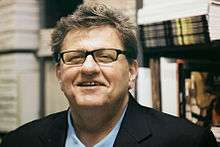Michael Schultz (gallerist)
Michael Schultz (born 4 November 1951) is an internationally active German gallerist. Michael Schultz Gallery / Galerie Michael Schultz operates in Berlin, Germany (2), Beijing, and Seoul. Thus he is running four galleries on two continents. The galleries provide cultural exchange, as Asian artists are shown in Europe and vice versa. The gallery in Berlin has preliminarily been closed at the end of October 2019.
Michael Schultz | |
|---|---|
 Michael Schultz in 2008 | |
| Born | 4 November 1951 |
| Nationality | Germany |
| Occupation | gallerist |
Biography and career
Born in Freudenstadt in Germany’s Black Forest on November 4, 1951, Michael Schultz, studied Music and Theater at the Freie Universität Berlin (1974–78). He was editor in chief of the now defunct “Berliner Kunstmagazin”. He went on to become the managing director of the Michael Wewerka gallery (Berlin). In 1986 he founded Galerie Michael Schultz, and branched out in 2005 with “schultz contemporary”. In the same year he also founded a gallery in Seoul (director: Cho Sung-sun), and in 2006 he established his fourth gallery, in Beijing (director: Hu Huijun). Gallery closed 2012. From 1985 to 2007 he served on the advisory board of Art Cologne art fair, and has been a member of the Art Committee KIAF, Seoul, Korea since 2005.[1] Since 2007 he is also a member of the Admission Committee for the “Art Fair.21”, Cologne, Germany. He is Co-Founder of the “MunichContempo” art fair, Munich, Germany, which started in 2010.[2] Michael Schultz is among most major art fairs' regular exhibitors, such as ARCO Madrid, Art Miami, Armory New York.[3] Michael Schultz also closely collaborates with a number of international museums, for which he curates and organizes exhibitions, such as the Georg-Kolbe-Museum in Berlin and the Kunsthalle Rostock,[4] the Today Art Museum, Beijing and with both the National Museum of Contemporary At and the Gwagnju Museum of Art in South Korea. On February 24, 2012 the 'Korean City of Art' Gwangju bestowed him with her honorary citizenship.[5] The gallery in Berlin has preliminarily been closed.
Artists represented
Michael Schultz mainly represents contemporary figurative artists from Germany, Switzerland, Austria, China, and Korea, like, in alphabetical order, Sonja Alhäuser, Arif Aziz, Chen Wenbo, Andy Denzler, Sven Drühl, Tommy Fitzpatrick, Feng Lu, Kristina Girke, Burkhard Held, Huang He, Huang Min, Stephan Kaluza, Kim Yusob, Bernd Kirschner, Helge Leiberg, Ma Jun, Joel Morrison, Römer+Römer, Cornelia Schleime, SEO, Bong Chae Son, Maik Wolf, Zhu Cao. On the secondary market he deals with Georg Baselitz, Markus Lüpertz, A. R. Penck, Sigmar Polke, Robert Rauschenberg, Gerhard Richter.[6]
Publications
More than 200 publications on curated artists and exhibitions:[7]
- Michael Schultz, German Idealism and Eastern Teachings. Basics of the Oeuvre of Joseph Beuys. In: Everyone is an Artist. Gwangju 2011 (exhibition catalogue Gwangju 25.8.-06.11. 2011).
- Michael Schultz (ed.): SEO. Personal Cosmos. Katalogbuch zur Ausstellung in Venedig. Biennale 04.06.2011-27.11.2011. Munich: Hirmer 2011. ISBN 978-3-7774-4111-5
- Michael Schultz / Arie de Knecht (edd.): Amador, Norbert Bisky, Burkhard Held, Jörg Immendorff, Stephan Kaluza, Katrin Kampmann, Helge Leiberg, Huang Min, Römer + Römer, Cornelia Schleime, SEO, u. a. Auf dem Weg ins Licht - Sammlung de Knecht. Berlin 2007. ISBN 978-3-939983-14-9
- Michael Schultz (ed.): A. R. Penck. Neue Arbeiten. Berlin 2007. ISBN 3-939983-13-6
- Michael Schultz (ed.): Robert Rauschenberg. selected works 1974–1999. Berlin 2007. ISBN 3-939983-06-3
- Michael Schultz (ed.): Norbert Bisky. Schlachteplatte. Berlin 2003.
- Michael Schultz (ed.): A. R. Penck. Variationen über ein Thema. Berlin 2002.
- Michael Schultz (ed.): Amador. Emersions. Berlin 2002.
- Michael Schultz (ed.): Luciano Castelli. Arbeiten aus den Jahren 1979 bis 1999. Berlin 2001.
- Michael Schultz (ed.): Markus Lüpertz. Gemälde aus den Jahren 1994–1999. Berlin 2000
- Michael Schultz (ed.): A. R. Penck. Dogma und Dialektik. Berlin 1999.
- Michael Schultz (ed.): Amador. Arbeiten 1994–1997. Berlin 1997.
- Michael Schultz (ed.): Amador. Februar-März 1995. Berlin 1995.
References
- Gerhard Charles Rump: Hungrig und neugierig. Zwei führende Galeristen über Deutschlands Freude am Kunstsammeln und den Mythos von der Leipziger Schule, in: Die Welt, 10. 02. 2006.
- Arno Widmann: Galerie Michael Schultz. Ein Gespräch mit dem Galeristen über den Kunstmarkt, die Krise, die Suche nach Beunruhigendem und über dem Kampf um die Verlässlichkeit in Berlin, Seoul und Peking, in: Berliner Zeitung, 04. 09. 2011; video-interview with M. Schultz on Vernissage-Tv about "MunichContempo".
- Galerie Michael Schultz on artnet.com.
- 2013 exhibitions Hwang Young-Sung and Andy Denzler
- Stephen Redeker: Michael Schultz: Honorary Citizen of Gwangju City, in: GwangJuNews, 28. 03. 2008.
- Eileen Kinsella: $25 Billion and Counting, in: ARTnews, 05. 02. 2008 .
- See entry on Galerie Michael Schultz in WorldCat; catalogue-entry in the German National Library (German); full list on the Galerie Michael Schultz's homepage.